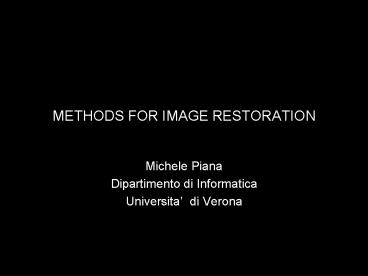METHODS FOR IMAGE RESTORATION - PowerPoint PPT Presentation
1 / 26
Title:
METHODS FOR IMAGE RESTORATION
Description:
METHODS FOR IMAGE RESTORATION. Michele Piana. Dipartimento di Informatica. Universita' di Verona ... X and Y are broad, since they must contain all possible ... – PowerPoint PPT presentation
Number of Views:164
Avg rating:3.0/5.0
Title: METHODS FOR IMAGE RESTORATION
1
METHODS FOR IMAGE RESTORATION
- Michele Piana
- Dipartimento di Informatica
- Universita di Verona
2
- Deterministic approach
3
DETERMINISTIC APPROACH
Functional analysis framework
Linear continuous operator AX?Y
4
DETERMINISTIC APPROACH
Remarks
- X and Y are broad, since they must contain all
possible - solutions and all possible (noisy) data
- The L2 condition for X and Y means that all the
signals - in the game must have finite energy
- In a finite-dimensional framework, X and Y are
Euclidean - spaces and A is a matrix
5
ILL-POSEDNESS
6
ILL-POSEDNESS
Well-posedness does not imply stability
Ill-conditioning
Remark finite-dimensional (well-posed) problems
coming from the discretization of ill-posed
problems are ill-conditioned
7
PSEUDOSOLUTIONS
The set of least-squares solution is closed and
convex in X
8
PSEUDOSOLUTIONS
Remark 1 ill-conditioning
Remark 2 compact operators
9
REGULARIZATION
10
REGULARIZATION
A simple model for image formation
11
TIKHONOV METHOD
One-parameter family of minimum problems
An optimal choice of the regularization parameter
is such that
12
TIKHONOV COMPUTATION
Matrices or (compact) operators
13
TIKHONOV COMPUTATION
Proof
14
TIKHONOV COMPUTATION
Remark Tikhonov method is nothing but a linear
filter!!
15
TIKHONOV COMPUTATION
Proof
The Euler equation becomes
16
TIKHONOV COMMENTS
- Computational heaviness for general operators
- Difficulties in accounting for sophisticated a
priori constraints
- General reconstruction behaviours effective
in smoothing, - less effective in enhancing edges or resolving
small features
17
DIGRESSION LEARNING
18
THE LEARNING PROBLEM
H is the hypothesis space and it is a RKHS
19
THE LEARNING PROBLEM
Regularization networks
More general loss functions the generalization
capability increases but the computational
effectiveness descreases
Remark there is still the problem of an optimal
choice for ?
20
LANDWEBER METHOD
Successive approximations
Landweber methodsuccessive approximations
applied to the least-squares problem (i.e., to
the Euler equation)
21
LANDWEBER METHOD COMPUTATION
Matrices and compact operators
Convolution
Remark even the Landweber method is a linear
filter
22
LANDWEBER METHOD COMMENTS
- The trade-off between stability and fitting is
realized by - optimally stopping the iteration high n means
- good fitting/bad stability small n means bad
fitting/high stability
- Tikhonov method and Landweber method behave
pretty much - the same
23
PROJECTIONS
In many problems it is possible to a priori know
that the solution belongs to a closed and convex
subset C of the solution space
Constrained least-squares problems
24
PROJECTIONS
Projected Landweber method
Remark this projection is well-defined for two
reasons
- C is closed and convex
- the solution space has good properties
25
PROJECTIONS
Super-resolution
projections onto closed convex subsets of good
solution spaces implies the regularity of the
Fourier transform of the regularized solution
Examples
- compactly supported functions the more the
support - is constrained the wider the band
- positive function a general theorm
(Paley-Wiener) - guarantees the regularity of the Fourier
transform
26
PROJECTIONS
Comments on the projected Landweber method
- many open (interesting) issues concerned with
- convergence
- computational heaviness preconditioned versions































